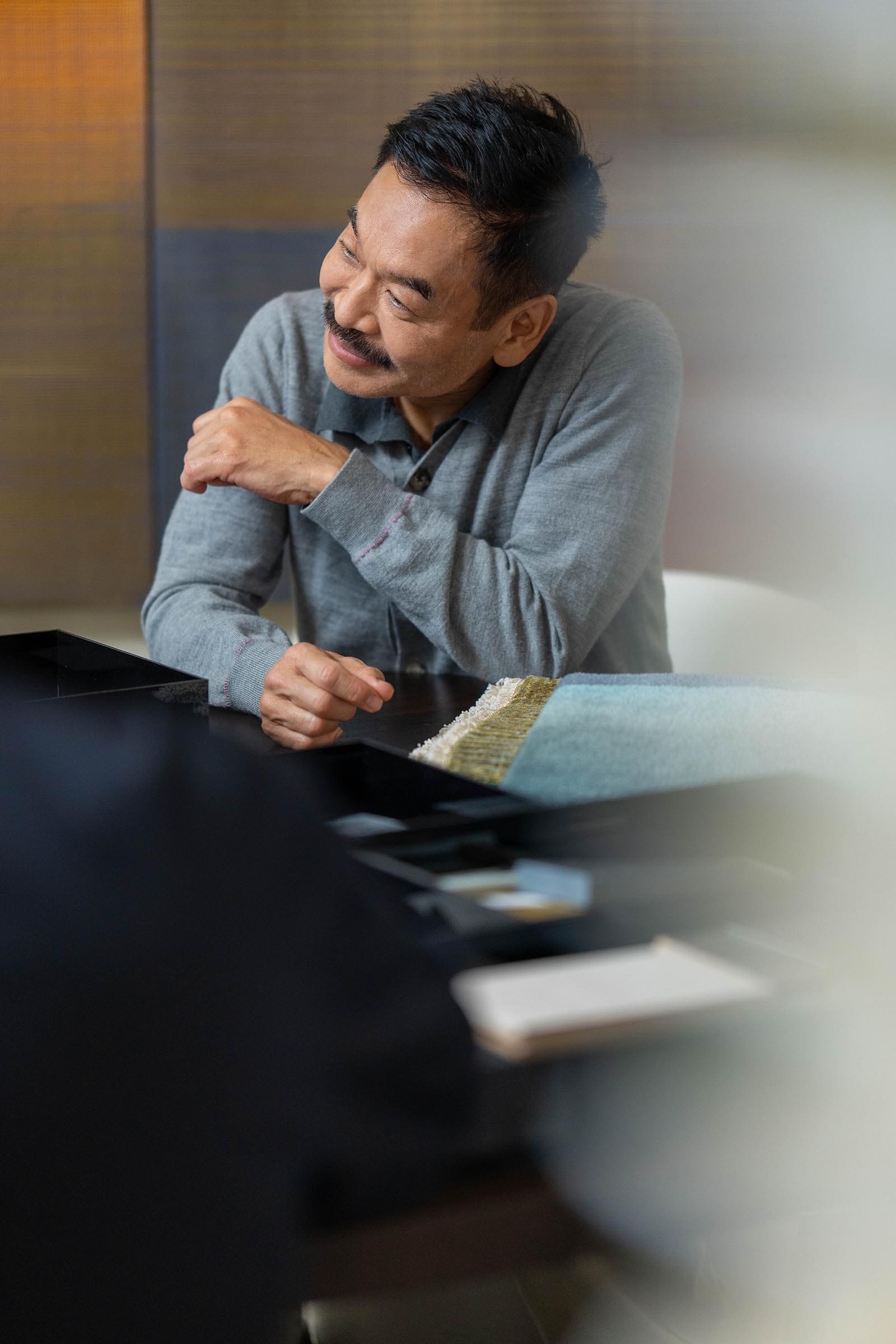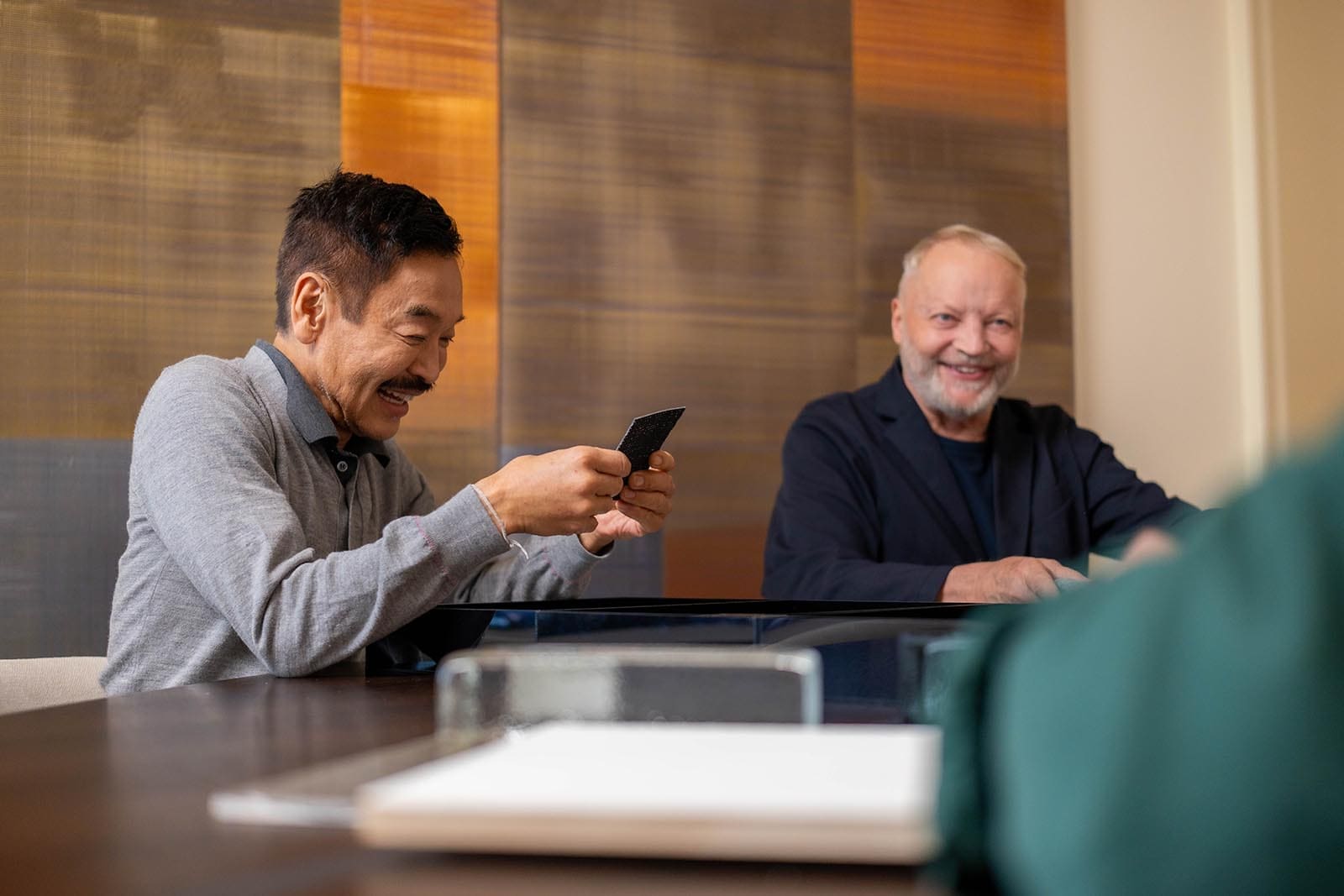George Yabu and Glenn Pushelberg sit for the lounge discussion hosted by Ayala Land Premier, “The Art of Design: A Conversation with Yabu Pushelberg.” Photo courtesy of HAVAS Red Philippines
George Yabu and Glenn Pushelberg sit for the lounge discussion hosted by Ayala Land Premier, “The Art of Design: A Conversation with Yabu Pushelberg.” Photo courtesy of HAVAS Red Philippines
The founders of the global multidisciplinary design studio Yabu Pushelberg talk to Vogue Philippines about the element of surprise and approaching new projects feeling first: Good design doesn’t have to be rational all the time.
Ask multidisciplinary designers Glenn Pushelberg and George Yabu about how they would define luxury within a space, and they would tell you about a trait that isn’t visible to the eye.
Pushelberg brings up their beach house in Montauk, New York, not to talk about any of the elements that fill the space but how the floors have developed a roughness over time. “I love being barefoot there because you feel the wood,” he muses. “To me, it’s [like being] closer to nature.”
This sort of experience is at the core of their practice. Hone in on one of their designed spaces, and you’ll find furniture and fixtures arranged to elicit a change in mood: a room that opens up from dark to light, spirited objects that dramatically shift in proportion, a corner that turns to a searingly red wall. “Our interiors tend to evoke feeling,” Pushelberg tells Vogue Philippines. “And that’s really about proportion, and surprise, sometimes—not being as rational.”

Yabu and Pushelberg play within this delicate balance. They find lucidity when they approach things from a different perspective. Yabu grinned as he described their design process as an endless “trial run,” one that has been ongoing for 45 years today and realized in their eponymous multidisciplinary design studio and a team of 100.
In their time, they’ve designed the interiors for the Four Seasons in downtown New York, Aman Residences in Tokyo, Park Hyatt in Shenzen, and built a name for themselves in fashion through their global retail spaces for Bergdorf Goodman, Lane Crawford, and Printemps. For each space, their approach revolved around a similar throughline, says Pushelberg: “How do you move people through three-dimensional space? How do you make spaces unfold naturally and create surprises?”
For Paris’ La Samaritaine, they found that sense of surprise almost by accident. The challenge then was working in a retail space within a historic frame, and making it feel relevant to today. The building’s Art Nouveau ironwork was originally painted over with yellow, which Yabu thought felt disruptive. Chipped at edges through the years, he thought he would strip it down to the raw metal underneath; the result was a visual dialogue between the past and the present, seamlessly flowing into one another.
“At the end of the day, we all know that color, fashion, whatever is temporal, is subjective,” Yabu explains, joking that the original 1920s architect must’ve just had an off day. Pushelberg furthers the thought, “I think what’s important as a designer is to build a strong identity to the environment.”


Yabu and Pushelberg would rather define their roles as problem solvers than designers, taking in the conversations that arise from the people and environment around them and then bridging a gap. The work is about finding inspiration from the constant feed of culture, fashion, art, and nature that motivates them.
For their latest project in collaboration with Ayala Land Premier, Park Villas in Makati, they aim to work in the nuances of Filipino culture and pair it with global connectivity. Right now, their ideas revolve around the Philippines’ “level of craft,” and they’re making plans to travel across the country to discover more raw materials and the work of our artisans. “We’re also curious to learn more about Filipino modern artists,” Pushelberg adds. “That’s also on our list.”
What they’re finding most exciting about the project is learning to understand Filipino people; Pushelberg observes a “fluidity of living” that’s unique, and it’s what Yabu Pushelberg plans to imbue in their interiors for the project. Riffing off the curvilinear form of the Park Villas buildings’ structure, they present rippling, organic forms and an emphasis on natural materials.
In any project they set out to do, Yabu says that what’s most important is a level of personalization. “I think the beauty of [seeing] our finished work is how people inhabit the space. That’s when you know if it’s really a success or not.” He smiles, “It’s not like living in a museum, right? It’s sort of austere, cold, no connection.”

They define the minimalism you would associate with these detached spaces as the opposite of modern relevance. They would rather tap into soft modernism, a category of design that, Yabu says, “tends to have more of a soul.”
All their methods come down to arranging visual elements to orchestrate a feeling. Visuals can stick with people; Yabu recalls his first interaction with design when he was eight years old, watching his craftsman father use traditional Japanese tools to break apart wood. He found joy in that particular preciseness it would always result in: “That straight line,” he mused. It’s a simple mental picture, but one that has stayed with him through his evolving design practice.
It’s the same for Pushelberg, who says he constantly found inspiration in what the people around him would create. Today, they’ve built on their dreams and turned them into a service. For others and for themselves, their aim is to bring imagined worlds to reality. Pushelberg says, “I think there’s something curious in me and in you.”
